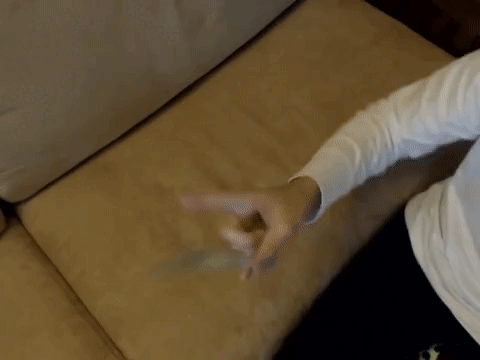Content made on Kapwing
This week, I’m doing something just a little bit different. Today’s edition will be a retrospective on the spinners who were most impactful and active in the CV’s of 2021, in various categories. Let’s get started:
“First Player” of the year: Sweg and Raijing
The “First Player” of the year is the spinner who was highly active and consistently created excellent combos, without necessarily being the most flashy spinner in the lineup. Sweg and Raijing both appeared in many top-tier CV’s this year, and while they occasionally outshone the rest of the cast, they most often provided very nice combos without being the main highlight.
“Interlude” of the year: Reamtea and Ence
The typical CV tends to have a quiet section in the music. Slower, calmer styles of penspinning (and most wiper-based combos!) fill these segments. When done right, they can make an even bigger impact than the louder, more exciting parts. The “Interlude” spinners of the year were both very active in CV’s this year and always – always – used a calm, down-tempo style to add dynamic to the cast.
“Beat drop” of the year: MG, EffecT, and Airi
Of course the last player tends to be the most memorable spinner in the cast of a CV, but in most cases, there’s a comparable combo placed somewhere in the middle. That’s how the music is often structured, so that’s the best way to structure the CV itself. Some sort of flashy climax also keeps viewers engaged. These three spinners had enormous impacts on the CV’s they were in. Often, they were the final spinners in the cast, but they stood out even when they weren’t.
“Last Player” of the year: Goat
You all know what being the “last player” of a CV signifies. Goat was, by a significant margin, the most impactful spinner in CV’s this year. With a phenomenal combination of flawless, effortless style, brilliant combo structure, and a gorgeous setup, every Goat combo hit hard in 2021. Let’s hope he keeps it going in 2022.
Now I’ll get into my views on the current aesthetic vs. technical debate! I’ll introduce this by saying that I allude to points made by Monheim without reproducing his full arguments here. I added a bit of clarification to my original dm’s in order to add context, but there may be some gaps that I didn’t fill. Still, the main parts of my argument should be easy to follow on their own. Here it is:
“I take extreme disagreement with the idea that aesthetic spinners in the high end have an extra degree of skill that cannot be pinned down” It can certainly be pinned down! In Goat’s spinning, for example, there’s a nearly obsessive hand form retained throughout the combo. Fingers deviate from this form to a degree that combines minimal motion (like Altema) with charge fullness (like Hash) and complementary motion with the tricks performed (like Herenz). Fingers always return to this form when possible, creating a sense of mechanical precision and delicacy. I say these are easy to pin down because they satisfactorily account for Goat’s style: by mimicking these attributes, I can do a pretty decent Goat impression with very simple material! I am able to replicate this aesthetic effect through practice and habituation. The fact that I can only achieve it with simple material shows that both mechanical effect and material difficulty are skills that similarly require effort and intention to develop.
That’s all pretty boring and mechanistic, but it’s an accurate description of a phenomenon that contributes to skill and pleasant effect. One actually interesting point is that, as you would likely point out, Goat’s spinning may not look as good with other angles! That’s because the deftness of Goat’s effect has been developed strategically to create a certain effect with a certain set of presentation parameters. This makes his skill set less versatile for different settings than, say, EffecT’s skill set, but the degree of skill is just as difficult to attain.
“even if we were to give you the same lighting scenario as say goat or aimo, saturation or even hue (because different hues have different values inherently) may change the overall effect of the composition” This is partly true! I am certainly not oblivious to these things, and on top of that they aren’t very difficult to discern and parse, really. Let’s inspect Esaya combos with vastly different visual compositions.
https://www.youtube.com/watch?v=ES3_ocNZIIA This combo looks beautiful! By my view, the setup enhances the smoothness of the hand and the contrasts of the pen, hand, and desk. The archetypal “carries” setup. I also think the spinning looks excellent, with my attention on finger forms, finger/pen/hand motions, and pacing dynamics.
https://www.youtube.com/watch?v=bfbL9zFDR3U Now let’s look at this combo. This setup doesn’t look great! The setup and lighting make it hard to see the pen clearly, the colors and shades of the hand don’t look very good, and the contrasts are all a mess. The shape of the hand is, at best, not enhanced by the composition. The point is that these are not hard to distinguish on their own. But, I can also discern that the spinning, down to very small details, looks just as excellent as the other combo. Probably even a little better!
The point here isn’t that Esaya is doing anything spectacular – this aesthetic level is probably equal to the technical level of fLow or Naru. But here’s the point in brief: you and i.suk have never made a combo that is nearly as pleasantly perfect as these combos. That’s my impression as a viewer: neither of you has ever done this.
The important conclusion of this point is that both of you could. i.suk is able to achieve at least the aesthetic skill of Chicken. They have similar hands, but if you placed i.suk at Chicken’s setup today, he wouldn’t be able to achieve anything close to chicken’s aesthetic effect. It would take a few years of effort, at least. The same goes for you and, say, Kudo.
The point is not that these spinners have necessarily put in as much effort as you or i.suk! Maybe their aesthetic achievements are over-glorified and misconstrued by some! But they have put in plenty of effort, real effort, to reach their current state, and these hard-won aesthetic details pay off to a discerning viewer in a way that can’t be mimicked by visual composition and “carries.”
Look at spinners who copy Drowsy’s combos with very nice macroexecution and the same exact carries (slimmer hands, too) but end up creating fairly boring videos that aren’t worth watching twice, because the smaller details of performance aren’t there. There are probably newer spinners who think these copies are close to Drowsy’s originals, but this simply isn’t the case.
So I think it’s very misguided to say with certainty that it’s easier to become Lumo than Vanilla. My view is that Vanilla could become Lumo with years of effort, and that Lumo could become Vanilla with years of effort. The fact that they both reached their current levels in only 2 years is similarly impressive for both, and indicates respective affinities for the things they worked to achieve.
I share your frustration in one specific way: some active aesthetic spinners haven’t really improved over the fast 4-5 years, and they get lots of praise and high status despite this stagnation. Spinners with a technical focus don’t get this luxury. If i.suk spun like his ’17 self, people would be so sick of his shit, myself included.
It used to be the case, I think, that technical spinners used to get away with this sort of stagnation, as well. It’s easy to remember just how stagnant some technical spinners were from 2011-2015, while getting tons of recognition for holding down their corner of material/style. Over the past few years, this has definitely changed, and technical spinners are expected now to consistently expand and improve their abilities, with people like i.suk, Iteza, Herenz, Noel, Katts, and DArKT responding to this demand very well. While some aesthetic spinners also improve their material, abilities, and styles regularly (including Goat, again), I agree that they don’t generally have the same pressure to do so.
Now I’d also like to address your analogy with visual arts, which is expressed well and is convincingly relevant, to some degree, to our ps discussion. But instead, I’m going to talk about instrumental music, which I understand better and which I think marries mechanical input with perceived effect more closely.
I’m working on a specific piece on the piano, and it’s at the upper range of my technical ability, and stretches it a bit. Getting the notes down and developing the muscle memory to play the piece was fairly difficult, and it took around 6 weeks.
If I played it today for someone who doesn’t play the piano, I could play it very expressively and they would be impressed to some degree by the technical level. At points, they would also probably appreciate the “grand gesture,” to borrow your phrase, of the expressive aspects.
If I played it for someone who is more experienced than me at playing piano, they would tell me that it’s fine. It’s alright. More importantly, they would tell me that I have a ton of work to do on voicing, which, on the piano, refers (you may know this, idk) to precise differences in volume between notes, used to enhance melody and line. This is relevant to our discussion because this voicing is purely mechanical, nothing more than force differentials among the fingers. It’s also perceived differently depending on experience: a person who doesn’t play the piano may think that my playing is better and notice its expressive qualities more easily if my voicing control were better, but they wouldn’t likely be able to attribute this to my mechanical precision (roughly the opposite of your point about inexperienced painters misattributing effective expressive gestures to mechanical detail). A person with a lot of experience, on the other hand, would recognize the precise reason for this improvement.
They would also recognize the difficulty of attaining this detail. I can say from experience that working on the subtleties of voicing has been significantly harder than learning the notes, and it only has to do with mechanical skill.
It also has nothing to do with “carries”! Someone who has never played piano could hear a novice playing on a very good piano with very good recording quality and say “wow! they sound so good!” Conversely, a more experienced pianist might listen to a skilled player on a mediocre instrument or in a room with poor acoustics and have no trouble discerning their skill in voicing. They would still, however, recognize that the skilled player sounds better on a good instrument or in a better acoustic space. So while “carries” like instrument, acoustics, and recording quality can make a huge difference on the outcome of the performance, a discerning listener has no difficulty distinguishing elements of mechanical skill, with or without “carries.”
Another interesting thing to draw from this is that it doesn’t take much time for someone to be able to play something easy on the piano nearly as well as the best pianists in the world. It is harder to learn how to play something very difficult badly. It is far, far, far more difficult to learn to play something difficult well. Similarly, it’s not too difficult to copy a very simple combo with high aesthetic skill. Goat’s material, on the other hand, or Drowsy’s, is much harder to copy with high levels of aesthetic skill, especially with their specific effects.
I’m convinced by your analogy with visual arts – there is room for misattributing the pleasant effects of visual composition to penspinning skill. I think your point relates well with penspinning composition and performance, to a degree. But as I tried to demonstrate using Esaya’s combos, I think it finds its complement more closely with the instrument/acoustics distinction I made, rather than my discussion of voicing.








































